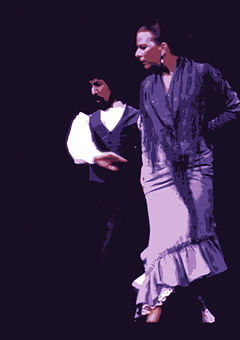About the Company
Ballet Flamenco La Rosa was founded in 1985 by Choreographer/Dancer/Instructor Ilisa Rosal.
Having been trained by some of the most important Flamenco artists while working with the finest companies, dancers and musicians in Spain,
Ms. Rosal returned to her native Miami to establish
a Flamenco Dance Company and School.
Flamenco is an art form that originated in Andalusia, Southern Spain, as a folkore that developed among families, neighbors and friends beginning in the Middle Ages. At that time, Arabs, Gypsies, Jews, Africans and Europeans coexisted in a Golden Age of cultural development that gave birth
to this new art form, as well as many other developments in the arts and sciences. Under the tyranny of the Spanish Inquisition, Flamenco became a kind of protest and an outlet for


Whether it is in Pure Flamenco works,
Cross-Cultural Fusion or its signature
dramatic Flamenco Ballets inspired by great works
of theater and literature, Ballet Flamenco La Rosa has captivated audiences, students and artists alike, becoming a local treasure and an international influence on the art form.
The mission of Ballet Flamenco La Rosa is to present authentic Flamenco dance with live music in a theatrical setting, expanding the art form beyond traditional limits to appeal to broad based audiences.
The School has trained many professional artists and educated generations of audiences about this art form. The Company has continued to excel by nurturing a strong foundation in the Pure Flamenco tradition, while creating new works and maintaining and developing relationships with the highest level of dancers and musicians from Spain.

Inspired by its mentor, Manolete, one of the most important gypsy flamenco artists of our time, the Company has kept a strong connection to the roots of the art form with ongoing international exchange and collaboration.





When Flamenco artists began to perform in cafés
as professional artists, the first such venues were called
Café Cantante (for singing) and Tablaos (for dancing).
In these settings, the Cuadro Flamenco was presented
much as in its original setting, with dancers, singers,
and guitarists seated in a semi-circle accompanying
with palmas (handclapping) and jaleos (shouts of encouragement and accent to the rhythm) as they took turns interpreting the various rhythms and melodies with improvisations. Later, Flamenco began to be introduced in the Theatre in Spanish Ballets, Operas, and Zarzuelas and inspired many works in classical music and classical dance. Choreography in the Flamenco style included complex group works and story Ballets. Flamenco has inspired writers, poets, sculptors, painters, composers and choreographers for centuries, and the art form itself has developed with many new influences in each generation. It remains a living art form, more powerful than ever in its contemporary form.
defiance and affirmation under great oppression for anyone who was not Catholic in Spain. The tradition of coming together to sing and dance held people together, and gave them strength to face the harsh realities of their lives. It became a part of their celebration rituals and social lives, and even gave them a livelihood, as Flamenco performers began to be sought after by the wealthy and powerful.



Having begun as a tradition of singing and dancing around a campfire, as was the case with the gypsies who traveled
in caravans or in cafes or patios while seeking refuge from the heat as is still the custom throughout Andalusia, this informal gathering is still the purest form of Flamenco.


